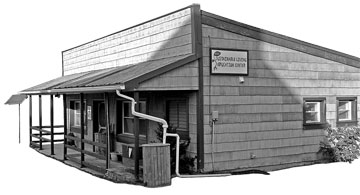
AV's Intern Team | January 3, 2009 | No Comments
By Maureen Halsema
The sun was shining, the wind was blowing and the energy was flowing into the little office in Floyd, Va.
“You can’t miss it,” Billy Weitzenfeld said. “It’s the building next to the 42-foot tall wind turbine.”
The Sustainable Living Education Center, a branch of the Association of Energy Conservation Professionals (AECP), is a living example of efficiency and sustainability.
Billy Weitzenfeld is the executive director of AECP, a non-profit Virginia-based corporation founded in 1992 as a series of weatherization programs. The AECP stresses the importance of energy efficiency, renewable energy sources and green building technologies in order to conserve natural resources and the environment.
The purpose of the Sustainable Living Education Center is to provide active learning experiences through exhibits, model displays and working energy systems, such as a 1,000-watt wind turbine and a 102-watt solar panel that provide more than enough energy to light the office as well as heat the water.

The Sustainable Living Education Center in Floyd, Va., teaches people how to make changes to their homes to live more sustainably.
The wind turbine and the solar cell were installed approximately five years ago at a cost of $5 to $6 per watt. The wind turbine resulted from a collaborative effort with James Madison University’s Virginia Wind Energy Coalition (VWEC). The Sustainable Living Education Center put an anemometer up to measure the wind speed and direction for one year to determine whether the site had a reliable wind resource. Over the last five years, only one part has needed replacement.
The wind turbine is part of a hybrid system that works collaboratively with the solar panel, generating 12-volt energy. All of the energy that both systems produce goes into the same battery storage.
“So if the wind stops blowing and the sun starts shining, we still have power,” Weitzenfeld said.
While the upfront cost was more expensive that the small-scale wind power, the solar system has not had any expenses in terms of maintenance. The solar panel’s initial cost was approximately $10 per watt.
The center was constructed with efficiency and low impact in mind. The design used recycled and local materials, incorporating walls lined with wheat straw wallpaper and shelving made of sorgum stalks. Low-volatile organic compounds (VOC) paints were used, reducing toxins and contamination in the air, landfills, and groundwater supplies. The lumber is Forest Stewardship Council (FSC) certified, meaning that wood was extracted from well-managed forests. The floors were made of a variety of environmentally conscious materials, including bamboo, cork, recycled carpet, and even ambrosia maple taken from dead trees in Floyd.
Outside, attached to the drainpipe, is a water collection system.
“Just one inch of rain is equivalent, over time, to thousands of gallons of water,” Weitzenfeld said. “That water is not getting back into the underground aquifer because we direct storm water rather than collect it and reuse it.”
Using a water collection system, the recycled water can be used for non-potable purposes such as watering a garden, flushing toilets, showering, and washing clothes. With the use of a filtration system the water can even be reused for potable purposes.
A straw bale house is adjacent to the Sustainable Living Education Center, designed to show effective strategies of straw-bale construction, an extremely energy efficient means of housing.
“It is the best insulated building in Floyd County,” Weitzenfeld said.
The walls have a natural texture—in some places you can see the shape of the bales beneath the plaster and clay paint; it is reminiscent of a gingerbread home, smelling faintly of fresh straw, with large cathedral ceilings and natural lighting illuminating the space. A “truth window” was intentionally left to show the straw-bale wall interior.

The straw bale house, was built to show people an example of how to successfully construct a sustainable structure. Photos by Maureen Halsema
The straw-bale structure was designed using the in-fill method, meaning the frame was built with box beams made of white cedar and the space filled in with straw bales from Floyd. The windows and doors, made of ambrosia maple and poplar, were incorporated into the framing process, and the corners were finished with cinder blocks. In order to protect against moisture – which is an issue with any structure, but a particular concern for straw bales – the builders used an earthen plaster comprised of clay, water, sand and straw. The straw bales were hand-coated with two coats of earthen-based plaster. On the building’s exterior, a final coat of lime was applied as a moisture preventative measure; on the inside, the final coat was a layer of clay paint.
“The earthen-based plaster allows the building to breath a little better, and should moisture penetrate, this type of plaster would help to dry it out,” Wietzenfeld said.
The Sustainable Living Education Center is also used to teach people how to make small improvements at home in order to live more efficiently.
“Simple activities and behavioral changes can really change the world—it starts with an individual effort,” Wietzenfeld said.
To learn more about the Sustainable Living Educational Center, visit the website aecpes.org/SLEC or call Billy Wietzenfeld at (540) 745-2838.
Like this content? Subscribe to The Voice email digests